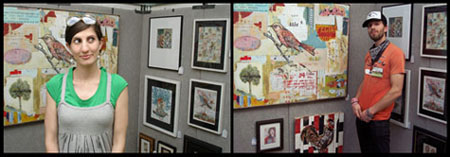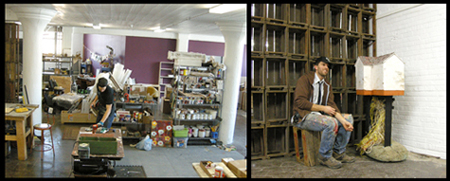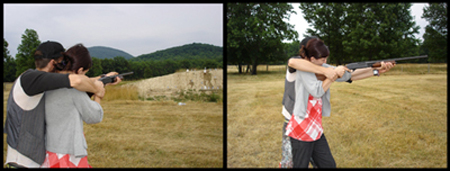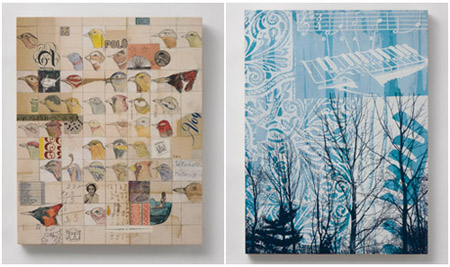An Interview with Dolan Geiman and Ali Walsh (original) (raw)
Feature Mon Jun 02 2008
For the past six years, Dolan Geiman has practiced his unique breed of Southern-influenced mixed media art in Chicago. While he's surely one of the most active artists in the city, we caught up with Dolan and Ali Walsh, his business partner and girlfriend, via email amid a much needed pause during their art fair season.

Ali and Dolan in their booth, Photos by The Georgia Red Mud Painter
Dolan, let's start at the beginning. I know your work is deeply influenced by your childhood in the Shenandoah Valley and Blue Ridge Mountains. Why do you think you connected so deeply with that environment? Can you please share a particularly powerful memory?
Dolan: That's an excellent question, and one that I continue to enjoy answering! As far as powerful memories, I have a handful. I was born in a hospital in Waynesboro, Virginia, and my folks lived in Hermitage, about four miles from there. My dad grew up in Crimora, and my mother in Waynesboro. This is important because it means I was nurtured by two individuals who had blood relations to the land and to the people of that region. Connecting to the environment was as natural for me as breathing. Every day, I awoke to the sounds of a mockingbird in the fire bush; I ate bacon, eggs and grits for breakfast; I worked outside helping my dad bail hay, chop wood, or de-worm cattle (a not-so-fun experience). So many people I know look at their life as just a big chunk of time working until the weekend, just biding time, waiting for the moments in-between the working. For me, I loved all the moments, working and non-working. I loved riding in the back of the pickup truck at my Paw-Paw's house, tearing apart hay bales for the cattle and kicking them off the truck as we drove through the meadow in the dark. I loved shucking corn with my Gran-ma in the tight, sticky summer air, when I wore cutoff Lee jeans and she kept shooing away the spotted barn cats with her sandaled feet. When my dad took a job with the forest service, I was two years old and it changed my life drastically. By the time I was 8, I was a naturalist with a desire to continue on that path. However, my mother's art career took off and I was introduced to life as a traveling art fair artist. I found this wildly appealing because I got to travel with my mother on weekends and see new regions of the state previously unexposed to me. I guess what I'm saying is from the day I was born until I moved away from Virginia, my head was filled to overflowing on a daily basis with new images and experiences. Inspiration was never lacking.
Given those connections, how do you feel about making Chicago home? How is your work affected by the distance?
Dolan: Ali gets tired of hearing me complain about living in Chicago. I remember hearing kids talk about being homesick in college, and I never understood it. For the past 6 years, I've been the poster child for homesickness. It's really pathetic. I visit home once a year, twice if I'm lucky. I still have trouble calling Chicago home, because I feel like it's still just a place where I work. It's hard for me because I have trouble relating to the people and the environment. I still feel like an outsider, honestly -- which for me is very troublesome, considering I have always enjoyed being close to my environment. Fortunately, I have a new studio in a green building and have met a handful of folks who I am happy to call friends. And I have learned how to appreciate this place for its character. (I sound like a Dad who doesn't like his daughter's boyfriend, don't I?) But I'm working on it. Having a studio with more light and space helps, and getting outside more often helps as well.
That's the emotional response, of course. On the other hand, my work has profited greatly. In the first three years I lived in Chicago I made approximately 1,500 new pieces. Not all of them were great, granted, but averaging 500 pieces a year is pretty good for an artistic output. Now I work just as manically, but it's a controlled manic. I work for deadlines 00 self-imposed of course -- but I have learned how to create a business out of making art, and that's pretty darn swell. I believe the distance from my home place has created this cathartic process for idea removal. I've been going through each and every memory -- seriously -- from when I was growing up, and taking those ideas and turning them into inspiration for new pieces. It's very intense, but I couldn't have done that by living in Virginia. Most people who leave Virginia or the greater part of the South have this rude way of describing it as "escaping the South." I have the opposite reaction. For me, it has allowed me a window into new inspirations and has forced me to dig deeply into my memory for those things that created my artistic tendencies in the first place.

Rescued Wood Constructions: Songbird and Trophy Deer collections, 2008, Photo by David Ettinger
Of course, the idea of a singular "work" is problematic in your case. You're involved in activities as seemingly distinct as painting and recycled clothing design. What are you currently producing, and what connections do you see throughout?
Dolan: I've stepped back from the clothing design and also from taking on ten projects at once, and have started to really hone in on my two-dimensional and three-dimensional work. I'm embracing the idea of being green, not because it's a buzz word, but because I actually believe it's a necessity for the sake of our planet. I've always considered myself green anyway, since I work largely with found objects and recycled materials, so it hasn't been a hard transition. But now, I'm really trying to focus on greening my paints and inks and even the wood I use. My work hasn't changed a whole lot in content, but I am always trying to come up with new ideas, and right now I've been working more with collage and three-dimensional found objects. I'm trying to use old magazines and books for these collages, and I'm playing with ways to use the entire magazine or book. It's also a space concern. I've got to much crap in this studio, and I need to make something out of it! I bounce around a lot in my studio -- some days making paintings and some days making collages -- so I'm constantly feeling the need to come up with things that excite me, so I can stay busy. That's never really been a problem, but in order to produce the work I want to produce and need to produce (for 20+ shows a year), I cannot afford a creative block. So I just keep making new stuff, and when I get stuck on an idea, I jump to something else.
With those broad activities and a heavy art fair schedule, a lot of creation and coordination must be required. What's a typical day like for each of you?
Dolan: For me, a typical day begins with eggs for breakfast, lots of coffee, and then I start something. Anything. I find it's important for me to get to the studio and instantly get started on something. It's kind of like waking up. If you lay in bed for too long, you just go back to sleep, but if you at least get out of bed and do something, it's easier to wake up. For me, if I just start cutting some wood or prepping some boards to be painted, I have greater success. Then I go through my list of things to do for the day. Usually I create a few paintings, burn some (silk)screens, package up some pieces to be shipped out to stores, start a collage or frame an existing collage, maybe create new images to be printed, and sometimes I answer a few e-mails. But generally I am creating from the minute I get to the studio at about 8:00 a.m. until about ten or eleven at night. Busier days start at seven and end at ... 2:00am? But I try to stay away from the computer, because it's easy for me to get distracted and want to look up vacation rentals in Colorado.

Dolan in the studio
Ali: It sounds like Dolan has adopted my sometimes unnerving ability to wake up and immediately start working! I think I actually start crafting e-mails in my head before I'm fully conscious. It's kind of scary. Thanks to our recent decision to separate our living and work spaces, we at least enjoy a little more normal morning routine: namely, breakfast at a breakfast table rather than breakfast at the computer desk/collage desk, respectively. Nevertheless, when we're in town, we always dash off to work as quickly as possible to take advantage of the precious time we have at the studio in between art fairs.
I think the biggest challenge for each of us is developing a systemic approach to each day's priority list. We're each trying to do the work of three or four people, so it's easy to get a little manic and bounce around to different activities. Dolan taught me to segment each day into hour-long blocks of time, each block devoted to a different task. For example, an hour for e-mail, a half-hour for bookkeeping, an hour for Etsy updates, two hours for long-term projects, etc. The challenge is making myself stop and move on to the next activity when the time comes, as my desire for perfectionism sometimes kicks in. I have my own office in our building, just down the hall from Dolan. I tend to stay out of the studio and on the computer. My job is to make sure Dolan can devote his time to what he does best, create artwork and respond to interview questions (haha). We are fortunate in that we have similar work ethics, similar visions for a sustainable arts business, and also complement each other's talents so well.
To what extent does collaboration with each other influence each of your practices? For example, has it played a role in ventures like clothing, decor, or even board paintings?
Dolan: Our collaboration as business partners has really helped me grow as a business-minded artist. We constantly throw around new ideas for marketing the work, or just discuss the types of artwork that I am creating or could create down the road. Having a left-brained person to bounce ideas off of is essential for me, and it allows me to have insight into a realm that I can't always approach.
Ali: Dolan is a calming influence. While we both work very hard, Dolan deals with enormous levels of pressure -- from the pressure to come up with new ideas and make artwork to situations like this week in which Dolan was filmed in his studio for national television. Dolan takes everything in stride and is a constant reminder to stay positive and not let the stress of this career path take over.
In terms of how our collaboration affects the production of work, I am very much the left-brained partner, providing research and reports to guide or inspire but certainly not direct the production of work. Whether it is by studying our art sales patterns for the last six months or setting Google Alerts to follow a certain trend or diligently reviewing blogs and small business websites, I am constantly brainstorming new ideas for the company, and we discuss these ideas via e-mail, structured meetings or over lunch, like many business partners. Dolan is receptive to these suggestions and also has a remarkable ability to build from the ideas while still incorporating them into his own aesthetic.

Dolan and Ali back home in Virginia
With all of that interaction, how do you see your work and personal relationships changing?
Dolan: Our work has grown rapidly, and I believe that it's because of the way our partnership works, appreciating each other's talents and not vying for lead-dog position. Our relationship has grown in different ways too, but I usually give that question a wide berth. We live and work together, so I should be happy that Ali hasn't knifed me in my sleep. I think to want more out of a business/life relationship than just your health would be selfish. You aren't showing this to Ali are you?
Ali: As one would expect, as our business grows, we don't spend enough time doing non-business related activities. But, like Dolan said, we spend every second together and are grateful that we continue to both work and play together so nicely. That said, having separate office and studio spaces is pretty nice (no more 90s grunge while I'm trying to write a legal contract).
You have some Chicago events coming up. What can we expect to see at them, and where else can we see your work in Chicago?
Dolan: You can expect lots of new work and possibly some new experimental pieces. I'll always have a few of my more intimate framed collage pieces, as well as my varied, nature-themed pieces, especially "tons of birds," to quote a recent art fan.
Ali: We have four shows coming up this June--57th Street Art Fair (Chicago, June 7/8), Old Town Fair (Chicago, June 14/15), Lakefront Festival of the Arts (Milwaukee, June 20-22), and Des Moines Arts Festival (Des Moines, June 27-29). We also update our online Etsy shop with new inventory weekly and post artwork, studio shots, and shots from the road on Flickr.

Field Guide Tennessee [left] and Do Re Mi (blue) box prints, Photo by David Ettinger
Any new projects on the horizon?
Dolan: I have a project in mind that I've been working on for several years, and I'd like to start it soon, but it involves my undivided attention and nothing really gets that right now, so I may have to slowly work on it. That's all I can say for now, but it involves water and burying things.
I want to turn the shared space behind my studio into a bird sanctuary, so that is something I am slowly working on. I also want to make it into a nature zone, with little signs identifying local flora and fauna. It sounds great and nerdy, but again, I just have to make time for it. It does involve being outside, so I think it will get prioritized.
Ali: We've been working on a website redesign for longer than I care to admit. Hopefully, by Bucktown Arts Fest in August, we'll have launched the redesigned site. Our developer happens to live in another country, so I'm crossing my fingers. We're also working on a wholesale catalog and, as part of that catalog, working toward additional green artwork lines.
About the Author:
David Schalliol is Managing Editor of Gapers Block and a graduate student in sociology at the University of Chicago. Visit his website, metroblossom, and that flickr place for more information about his projects.
